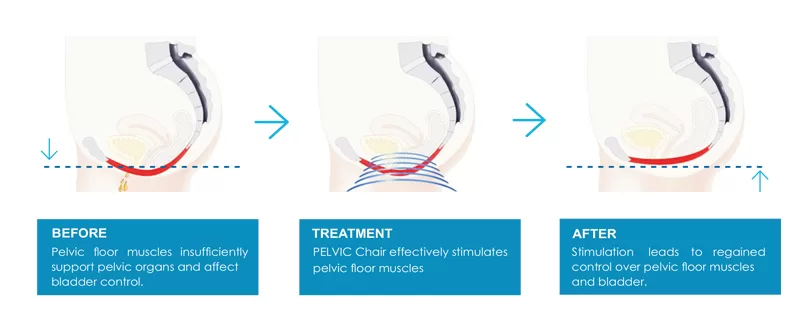Introduction
The conversation around pelvic floor health has shifted dramatically in the past few years—from a private, often-taboo topic to a central pillar of wellness, physical therapy, and rehabilitation medicine. According to a recent bibliometric study, research on pelvic floor reconstruction—particularly for pelvic organ prolapse (POP)—has steadily increased over the past two decades, with prominent focus areas including stress urinary incontinence, quality of life, and surgical innovations. As awareness grows, more people are discovering how pelvic floor machines can transform both clinical treatment and personal well-being. These devices are revolutionizing how we treat pelvic floor dysfunction.
In this article, we’ll explore how these machines are changing global wellness trends, review different treatment options for tightening and rehabilitating pelvic muscles, answer common questions, and introduce the innovative PZLASER PELVIC Chair, a new benchmark in pelvic therapy.

The Trends & Landscape of Pelvic Floor Health
From Taboo to Trend
Once rarely discussed, pelvic health is now one of the fastest-growing wellness sectors. Clinics, rehabilitation centers, and med-spas are investing in pelvic floor machines to meet the surging demand for safe and comfortable solutions—especially for women facing postpartum challenges or age-related muscle weakness.
Social media has played a key role in destigmatizing the topic. Influencers, therapists, and healthcare professionals are breaking taboos around incontinence, pelvic pain, and postpartum recovery. A notable example: Sara Reardon, dubbed “The Vagina Whisperer,” has amassed a large social following by addressing pelvic floor topics candidly and humorously. According to health industry data, searches for “pelvic floor therapy” have increased by more than 200% since 2018.
This change represents a major cultural and clinical shift—from reactive treatment to proactive prevention.
From less to more: Research & Clinical Focus
As mentioned earlier, there is an increasing amount of academic research on pelvic floor reconstruction. More broadly, a 2024 analysis of global research on pelvic floor dysfunction (PFD) identified “hotspots” such as non-invasive therapies, neuromodulation, and rehabilitation devices as fast-growing nodes in scholarly literature.
This academic momentum reflects what’s happening in clinics and wellness centers: an increasing adoption of non-surgical therapies, multidisciplinary collaboration (gynecology, urology, physical therapy), and demand for patient-friendly, device-assisted solutions.
From Physical Therapy to “Tech-Enabled” Treatments
Historically, the mainstay for pelvic floor rehabilitation has been pelvic floor physical therapy—manual methods, biofeedback, Kegel training, and patient education. That remains foundational. But in recent years, technology-enhanced modalities have rapidly gained ground:
- Pulsed magnetic stimulation is getting attention as a non-surgical approach for stress urinary incontinence and general pelvic floor strengthening.
- Devices using High-Intensity Focused Electromagnetic (HIFEM) energy—such as the well-known Emsella Chair, PZLASER Pelvic Chair —are making waves for their ability to induce thousands of deep pelvic contractions non-invasively.
- Integration of imaging, AI, and segmentation techniques is enhancing diagnostic precision: for instance, deep learning is now being applied to MRI of pelvic floor organs for accurate 3D modeling.
This shift is corroborated by professional reports showing a rising interest in pelvic floor specialization: among physical therapy students, interest in the specialty is growing at ~3–5% per year, and more PTs are now taking continuing education in pelvic health.

From tradition to technology Demand is constantly changing
Patients increasingly demand treatments that are comfortable, fast, and non-disruptive to daily life. Traditional surgical interventions, invasive techniques, or long courses of physical therapy—with their discomfort or downtime—are less appealing for many.
This demand fuels the adoption of non-invasive, device-based solutions such as pelvic floor machines. Clinics and med-spas are now competing based on patient experience, safety, and measurable outcomes rather than just manual skill. Pelvic floor machines emerge at the intersection of technolog, wellness, and medical care—a timely entry into this evolving market.
What Are The Pelvic Floor?
Let's go back to the beginning: what are the pelvic floor muscles, and why are they important?
The pelvic floor is a group of muscles and ligaments that support key organs like the bladder, uterus, and bowel. These muscles help maintain continence, stabilize posture, and even affect sexual health. When weakened or overactive, the results can include:
- Urinary leakage or incontinence
- Pelvic organ prolapse
- Chronic pelvic pain
- Postpartum weakness or instability
Strengthening and retraining these muscles through pelvic floor machines and therapy can help restore confidence, comfort, and quality of life.
How to Tell If the Pelvic Floor Is Tight or Weak?
One of the most common uncertainties for patients: Is my pelvic floor too weak, or is it too tight? The diagnosis influences therapy direction (strengthening vs. releasing).
| Condition | Common Symptoms | Recommended Treatment |
|---|---|---|
| Weak Pelvic Floor | Urinary leakage, pelvic heaviness, poor control, reduced sexual satisfaction | Strengthening with Kegels, electromagnetic Pelvic Floor Machine sessions |
| Tight Pelvic Floor | Pelvic pain, painful intercourse, constipation, frequent urination | Manual release, breathing therapy, pelvic floor relaxation techniques |
While both conditions can coexist, an experienced therapist can assess tone and design a personalized program combining Pelvic Floor Machine sessions with targeted exercises.

Pelvic Floor Machine Therapy: Methods for Pelvic Tightening and Rehabilitation
Pelvic floor therapy includes a variety of treatment methods—ranging from manual therapy and biofeedback to behavioral coaching and advanced device-based solutions. Below are the most effective and scientifically recognized approaches for pelvic muscle rehabilitation.
Manual Therapy and Pelvic Floor Massage
Manual therapy is the foundation of pelvic rehabilitation. Therapists use internal or external massage techniques to release tension, reduce spasms, and improve circulation in tight pelvic muscles. Pelvic floor massage is especially effective for patients with hypertonicity or chronic pelvic pain before introducing strengthening exercises.
Biofeedback and Electrical Stimulation
Before the rise of magnetic devices, biofeedback machines helped patients visualize their muscle activity on a monitor, allowing them to learn how to contract or relax the pelvic floor properly. Some devices also provide electrical stimulation, gently activating weak muscles.
Behavioral Guidance and Lifestyle Adjustment
Pelvic floor dysfunction isn’t just about muscles—it’s also behavioral. Physical therapists often educate patients on posture, breathing, and daily habits. Avoiding “power peeing,” straining during bowel movements, and chronic sitting can make a huge difference. These changes amplify the results of using a Pelvic Floor Machine.
Yoga and Stretch-Based Therapies
Gentle yoga poses—like the Bridge Pose or Child’s Pose—encourage pelvic alignment and balance. “Yoga for pelvic floor” is gaining traction as a complementary therapy that promotes awareness and helps integrate relaxation with strength.
Advanced Pelvic Floor Machines (HIFEM Technology)
The newest generation of Pelvic Floor Machines uses electromagnetic energy to trigger deep, involuntary muscle contractions. This high-frequency magnetic stimulation reaches muscles that traditional Kegels can’t fully engage. Just like PZLASER has a Pelvic Chair—In just one 30-minute session, a HIFEM-based Pelvic Floor Machine can simulate up to 12,000 Kegel exercises, dramatically improving strength, tone, and neuromuscular coordination. This approach is painless, non-invasive, and requires no recovery time—making it ideal for modern clinics and wellness centers.
Common FAQs About Pelvic Floor Machines
What is a Pelvic Floor Machine and how does it work?
A pelvic floor machine is a therapeutic device (whether electromagnetic, electrical stimulation, biofeedback, or mechanical) designed to stimulate and train pelvic floor muscles. For example, devices using HIFEM (High-Intensity Focused Electromagnetic) technology send magnetic pulses that trigger intense involuntary muscle contractions deep in the pelvic region, mimicking thousands of Kegel exercises in a short period.

How long before I see results?
Most patients feel improvement after just one or two sessions. Noticeable results—like reduced leakage or better muscle control—typically appear after 6–8 treatments.
Are pelvic floor machines safe and painless?
Yes—when used properly and under guidance. Most devices are non-invasive and painless. The sensation is often described as mild, with a feeling of tapping or tingling. There is typically no downtime, and patients remain fully clothed throughout the procedure.
Do men have a pelvic floor?
Yes, men also have pelvic floor muscles. The pelvic floor in men supports the bladder, prostate, and rectum, and helps control urinary and fecal continence, as well as contributes to sexual function (erection and ejaculation). Therefore, men can experience pelvic floor dysfunction (e.g., after prostate surgery, pelvic trauma), and may benefit from therapy or devices. Post-prostate surgery patients often use Pelvic Floor Machines for rehabilitation.
Should I strengthen a tight pelvic floor or relax it?
It depends. If your pelvic floor is weakened, strengthening is the goal. But if your pelvic floor is overactive or hypertonic, the first goal is to relax or release tension (often via manual therapy, stretching, dilation, or neuromodulation) before attempting strengthening. Misguided strengthening on an already tight muscle can worsen symptoms.
PZLASER PELVIC Chair – A Breakthrough Pelvic Floor Machine
PZLASER’s PELVIC Chair represents the next evolution in Pelvic Floor Machine technology. It’s sometimes referred to as a "pelvic floor machine," "pelvic chair," or "pelvic floor therapy device." It is a fully non-invasive device that uses High-Intensity Focused Electromagnetic (HIFEM) energy to stimulate deep pelvic floor muscles. During a 30-minute session, muscles contract in response to the electromagnetic pulses, achieving the same result as 12,000 Kegel exercises.

- Entirely Non-Invasive: No surgery, no medication, and no internal contact.
- No Pain, No Downtime: Patients can immediately resume normal life.
- Clinically Proven: 95% of patients report improved bladder control and quality of life.
- Smart On/Off System: Ensures safety and comfort during treatment.
- Remarkable Results: Noticeable improvement after a single session.
- Comprehensive Applications: Effective for stress and urge incontinence, postpartum recovery, and pelvic floor rehabilitation.
Why Clinics and Patients Love the PELVIC Chair?
- Efficient Treatment Cycle: Each session lasts just 30 minutes with visible improvement.
- Comfortable Experience: Patients remain fully clothed and seated—no embarrassment, no pain.
- High ROI for Clinics: Quick sessions, no consumables, and broad patient appeal.
The PZLASER PELVIC Chair is more than a device—it’s a symbol of how modern technology can empower women’s health and redefine confidence.

PELVIC Chair Suggested Treatment Protocol
A sample protocol (for illustration; actual parameters to follow manufacturer guidelines) could be:
| Phase | Frequency | Duration per Session | Sessions per Week | Total Course |
|---|---|---|---|---|
| Induction | 2–3 times/week | 20–30 min | 2–3 | 4–6 weeks |
| Consolidation | 1–2 times/week | 20 min | 1 | 4–8 weeks |
| Maintenance | 1 time/2–4 weeks | 20 min | – | Ongoing |
- Before treatment: Evaluate baseline via physical exam, symptom questionnaires, or pad test.
- During treatment: Ensure correct seating position and comfort.
- After treatment: Encourage complementary exercises and lifestyle modifications.
Conclusion: Towards a Healthier, Confident Future
The pelvic floor, once a "quiet core" often overlooked until symptoms appear, is now coming into its own as a central element of women’s (and men’s) wellness. The convergence of rising public awareness, research momentum, and patient expectations has set the stage for technology-enabled rehabilitation to play a leading role. Devices such as pelvic floor machines, especially those built on electromagnetic stimulation, offer transformative potential in efficiency, patient comfort, and therapy outcomes.
Within this landscape, PZLASER’s PELVIC Chair stands poised as a flagship solution—merging advanced, non-invasive design with clinical-grade efficacy. For wellness centers, gynecology clinics, and aesthetic or medical spas, it provides a compelling offering: a tool that delivers measurable results, a patient-friendly experience, and scalable operational capacity.
If you are considering introducing pelvic floor machine therapy or upgrading your clinic’s women’s health portfolio, the PZLASER PELVIC Chair is a cutting-edge, credible, and future-forward option to explore. Beyond recovery, it’s about redefining wellness.






